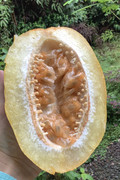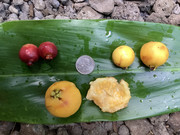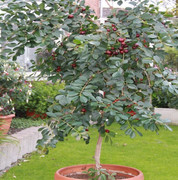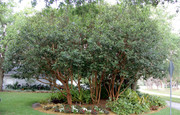1
Tropical Fruit Buy, Sell & Trade / Selling: Passiflora quadrangularis & Psidium cattleianum var. littorale seeds
« on: October 27, 2022, 12:38:22 AM »
Just harvested some of my Passiflora quadrangularis (Giant Liliko’i) and have some extra seeds left over beyond what I propagate for local sale. They make very large fruits that turn a green-orange color when ripe, smell incredible and the edible pulp is quite sweet with a pleasant amount of acidity, making for a flavor that lends itself to fresh eating. These and the Jamaicans are my personal favorites of the Passifloras. The flower petals on mine aren’t the vibrant red like the ones you see in online images, instead being more of varying shades of light purple, otherwise everything else is the same. These require a sturdy trellis, as they weight from the fruits quickly adds up! The vines will get sprawling and massive if allowed, however I’ve had excellent fruiting success with pruning them heavily to keep them more compact and manageable.


This year I’ve also selected the largest fruits I’ve found from thousands of the yellow, sweet-fleshed Psidium cattleianum var. littorale (yellow Strawberry Guava, Waiawi) that grow wild on my property, and am making seeds available. There are 2 trees which produce these extra large fruits consistently and grow right next to each other. At this time I do not have clones/cuttings available as they’re both about 40 feet tall, but may be able to do that in the future. The fruit is nicely sweet with a very distinctive and (I think) lovely overall flavor, having a gentle degree of that characteristic guava flavor that is much less pungent than P. guajava, while also having far, far less acidity than the common red P. cattleianum. The overall flavor is nicely balanced and is very pleasant as juice, for fresh eating, made into ice creams or smoothies in my opinion.
The plants themselves make beautiful specimen trees with their orange-red bark and dark green shiny leaves. They handle heavy pruning/pollarding/coppicing well, can be kept quite compact (and fruit very well like this), do well in pots, and can handle lower light levels, making them pretty well suited to greenhouse life. You can also train them when the stem is out of the green phase and is in young bark, as they are very flexible in this stage. I’ve made living fences out of them on my property to contain livestock in this way.
On left regular red Waiawi fruits (P. cattleianum, “strawberry guava”) shown next to regular yellows on right, with large fruit compared on bottom:

Showing the bark:


A photo to demonstrate how productive these trees are; this is a wild tree growing not 10 feet from my house, which was unceremoniously topped and has never been fed or given any care, and I counted at least 112 visible fruits developing. If fed and cared for they can produce even better:

Some examples of what others have done with them in pots and in the landscape:


Prices:
Passiflora quadrangularis @ $1 per seed
Psidium cattleianum var. littorale, large fruit selection @ $1 per seed
Germination rates for both have been very high in my experience.
Please PM if interested.


This year I’ve also selected the largest fruits I’ve found from thousands of the yellow, sweet-fleshed Psidium cattleianum var. littorale (yellow Strawberry Guava, Waiawi) that grow wild on my property, and am making seeds available. There are 2 trees which produce these extra large fruits consistently and grow right next to each other. At this time I do not have clones/cuttings available as they’re both about 40 feet tall, but may be able to do that in the future. The fruit is nicely sweet with a very distinctive and (I think) lovely overall flavor, having a gentle degree of that characteristic guava flavor that is much less pungent than P. guajava, while also having far, far less acidity than the common red P. cattleianum. The overall flavor is nicely balanced and is very pleasant as juice, for fresh eating, made into ice creams or smoothies in my opinion.
The plants themselves make beautiful specimen trees with their orange-red bark and dark green shiny leaves. They handle heavy pruning/pollarding/coppicing well, can be kept quite compact (and fruit very well like this), do well in pots, and can handle lower light levels, making them pretty well suited to greenhouse life. You can also train them when the stem is out of the green phase and is in young bark, as they are very flexible in this stage. I’ve made living fences out of them on my property to contain livestock in this way.
On left regular red Waiawi fruits (P. cattleianum, “strawberry guava”) shown next to regular yellows on right, with large fruit compared on bottom:

Showing the bark:


A photo to demonstrate how productive these trees are; this is a wild tree growing not 10 feet from my house, which was unceremoniously topped and has never been fed or given any care, and I counted at least 112 visible fruits developing. If fed and cared for they can produce even better:

Some examples of what others have done with them in pots and in the landscape:


Prices:
Passiflora quadrangularis @ $1 per seed
Psidium cattleianum var. littorale, large fruit selection @ $1 per seed
Germination rates for both have been very high in my experience.
Please PM if interested.
